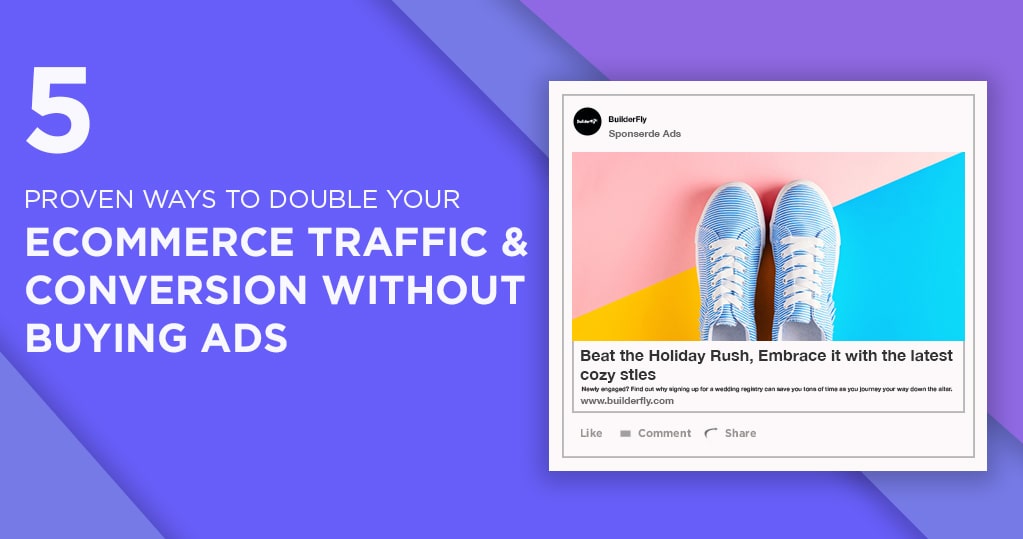You’ve launched your eCommerce store, you’ve shared it with friends and family, and now… you wait.
But what happens when the traffic doesn’t come? If there’s no traffic, there are no conversions. If there are no conversions, there’s no profit.
More terrible, what happens if the traffic comes, however, it’s all the wrong people? You know, people who aren’t probably going to part with their money for your products since they’re the wrong segment, the wrong demographic.
Can I boost traffic without buying ads?
Ecommerce is growing at a rate of 23%, year over year, and will only continue to grow, thanks to the availability of mobile devices and the Internet of Things.
Far and away superior — eCommerce sales are relied upon to top $2.4 billion this year. The problem is, it’s hard to rise above the competition without spending a fortune on advertising, right?
That’s a common misconception. Larger retailers with huge budgets will in general throw money at their marketing issues. So smaller retailers without unlimited marketing and advertising funds may feel like they are at a disadvantage.
Luckily, there are plenty of ways to drive traffic and gain customers without breaking the bank.
1. Upsell
Many smaller eCommerce stores ignore one of the most accessible selling weapons in their arsenal: upselling. There is a false impression that it isn’t worth the effort, but that’s not the case.
Upselling can drive an average of 4% more sales within your current customer base alone. It might not sound like much, but it adds up when you consider it to your entire revenue stream.
The very first year that Amazon tested upselling on their platform, they increased sales by 35%. Base suggestions on either complementary products, guarantees or logical bundles, like this are example from Amazon.
Don’t leave money on the table. It’s 68% more expensive to get a new customer than it is to upsell to a current customer. If upselling can boost sales up to 35%, then what do you have to lose?
2. Don’t Forget About Social Proof
More than 92% of consumers trust a recommendation from a friend, and 70% trust a recommendation from a stranger. Social proof is exactly what it sounds like. It’s proof that your peers (or at least a big chunk of the population) trust a brand enough to buy from it.
How does this translate into conversion? Look at Express Watches. They increased conversions over 58% by using social proof:

All it took was one little review widget. Worth a shot, right?
3. Go Mobile
60% of mobile users have purchased something online from their mobile devices. Whatever you do, don’t forget to optimize your site for mobile shoppers.
So what does optimization look like? Here are a few highlights consumers said are important to them on a mobile site:

After you start adding features, if you want to know if you’re on the right track, enter your URL on a page like the Google Mobile-Friendly Test to see how it stacks up.
4. Strategize SEO
We all know SEO is important, and yet sometimes we let it “happen by accident” instead of giving it the attention it deserves.
Nearly 93% of web traffic comes from a search engine, and under 5% of web searchers find it through to the second page of returned search results. you should be on that first page, friends.
Pay attention to the product keywords you should be using. Use a tool like the Google Keyword Planner to guide you to the right list of words that are the most relevant to your product.

5. Sell Benefits, Not Features
Consumers buy things to solve problems. 20% of missed sales are caused by poor product descriptions that are geared to brag about a product instead of offering a solution.
An easy fix? For every feature you’re tempted to write about, think of a correlating benefit to your consumer. You’re selling against everyone in your space. Give your visitors a reason to trust that your product is the only one that can solve their problem.
Conclusion
It’s not about getting the most amount of visitors to your store as fast as could be possible. Rather, emphasis on truly understanding your high-value customer segments. Who are they? Where do they go for online shopping? What do they do in their free time? The more you think about them, the better you can target them.
Pick the traffic sources that get you closer to those segments. More significantly, optimize the traffic sources you do try with to get the most incentive out of them.
Traffic acquisition is rarely cheap, regardless of whether you’re spending money or effort. So why waste your resources on awful traffic? Double down on relevant, fantastic traffic sources.
Do you have any more low-budget tricks and tips to offer retailers? Tweet us on @BuilderFly








